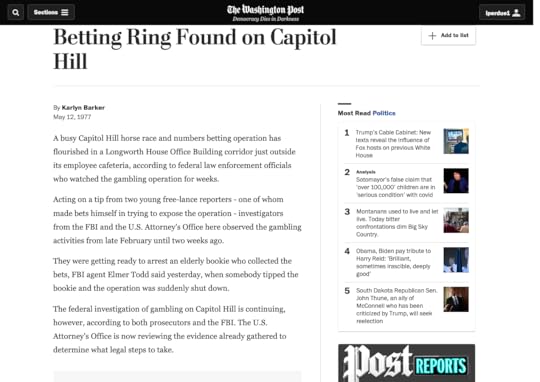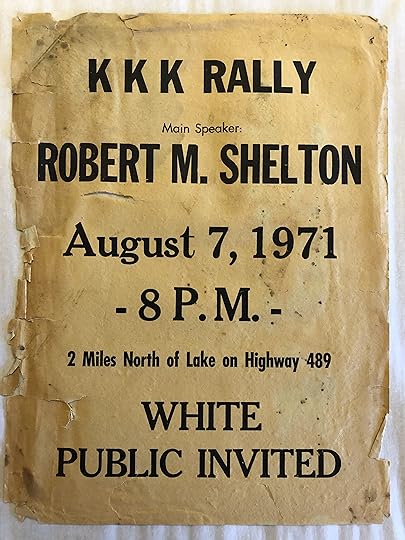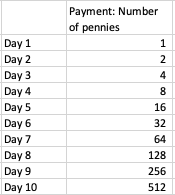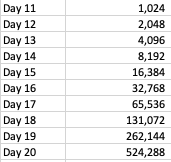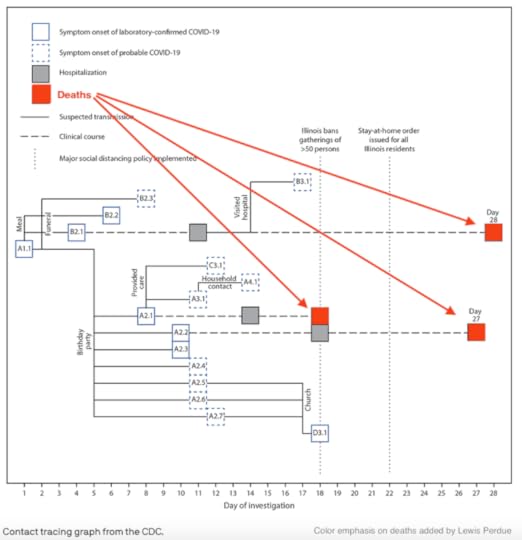Lewis Perdue's Blog, page 4
January 22, 2022
Title page … Why the title, Hellhound? — Edited Feb. 4, 2022
As the myth goes, legendary Mississippi Delta Blues guitarist Robert Johnson was a mediocre performer until, one midnight, he sold his soul to the Devil at a crossroads said to be the intersection of Highways 49 and 61 in Clarksdale.
At its most fundamental level, the myth is about choices.
Rarely do those decisions involve bartering our souls. But consciously — or unconsciously — we all find ourselves at times in our lives where we must make major choices. not always realizing that failing to make a choice is a choice of its own.
Much of Hellhound reflects my own look back.
Title page … Why the title, Hellhound?
As the myth goes, legendary Mississippi Delta Blues guitarist Robert Johnson was a mediocre performer until, one midnight, he sold his soul to the Devil at a crossroads said to be the intersection of Highways 49 and 61 in Clarksdale.
At its most fundamental level, the myth is about choices.
Rarely do those decisions involve bartering our souls. But consciously — or unconsciously — we all find ourselves at times in our lives where we must make major choices. not always realizing that failing to make a choice is a choice of its own.
We sometimes look back at choices we have made … wondering if we could have done better, wondering how our lives and those around us might have changed if we had made another choice.
In addition to soul-selling, there are thousands upon thousandy of quietly unrecognized, un-agonized choices determined by upbringing, experience, education as well as genetics, illness and injuries that solidify into a solid reality of where we find ourselves. Much of Hellhound reflects my own look back.
January 12, 2022
Nuclear Radiation Hazards of Burning Coal? (Yep!)
This is an article I wrote shortly after leaving my Washington D.C investigative reporting career and started teaching journalism at UCLA.
Ironically, this could be a worse hazard to public health than climate change. Yet, it has been ignored.
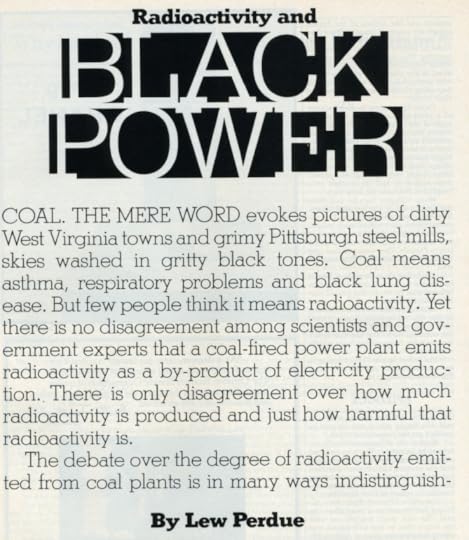 Read the entire article at this link (pdf): NuclearCoal-Perdue
Read the entire article at this link (pdf): NuclearCoal-Perdue
January 11, 2022
April 19, 2021
A genuine artifact of U.S. History with today’s social upheaval written all over it Ku Klux Klan Poster, 1971. Now an NFT.
NFT at OpenSea.
Summer job with U.S. Department of Agriculture between my junior and senior years at Cornell. Majoring in Ecology, Evolution and Systematics.
I did grunt work in the federal fire ant eradication program which involved the aerial dispersion of cornmeal containing the insecticide Mirex.
My job was to drive a beat-up pickup truck with no air conditioning all over Mississippi hell and gone, digging up fire ant mounds in various fields and pastures and record whether or not ants were still alive. Then mark those on a map.
On the way to examine one of the the areas, I spotted this document plastered to the back of a diamond warning sign.
It took me a while to make sure no one saw me, and I peeled it off. Kept it ever since as a reminder of a dark time I hoped would never come again.
Right click photo to view a larger image.
April 24, 2020
How 2 Billion pennies explain why social distancing is so vital to defeating COVID-19 (And not killing Grandma)
Note: This article is a cross-post of a March 20, 2020 article reprinted by permission of the Stealth Syndromes Project which underpins a study approved by the University of California San Francisco Medical School’s Committee on Human Research. The study is funded by the Center for Research on Environmental Chemicals in Humans.
These two exponential/geometric growth charts look a lot alike. But they represent two very different things.


To understand, first imagine you are owed a great debt.
The person who owes you money gives you a choice, but you have to respond right then.
Choice #1: $1 million immediately.
Choice #2: A penny.
A penny now, then two pennies the next day, and four the day after that. And so it continues for 30 days, doubling the pennies each day.
Which would you choose?
Most people choose the million upfront. After all, #2 seems like a losing choice because the numbers appear to add up too slowly.
2/3 through the month and the $1 million still looks like a better deal.
Then things explode as the effects of exponential growth become apparent
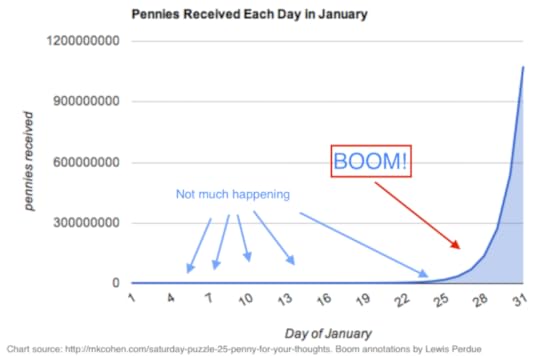
Right-click image to view a much larger version.
$21+ Million in pennies is clearly the best bet
And you will have plenty of funds to pay people to package all the pennies up and get them to the bank.
But how does that connect to COVID-19?
It’s all about second almost identical chart which shows the exponential growth of Coronavirus cases in the United States.
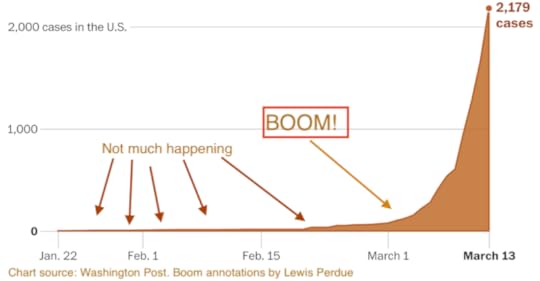
Right-click image to view a much larger version.
Just as the case of the penny payments disguise the huge amount at the end, the deceptive low levels of Coronavirus cases at the beginning have fooled many from realizing the coming onslaught.
Why is it vital to act quickly?
Take your Coronavirus as seriously as you should penny payments and the value of social distancing is apparent. In Coronavirus cases have dropped sharply in South Korea.
 What’s the secret to success? In South Korea, quick action, preparedness along with testing and strict quarantines are credited with “flattening the curve” and preventing it from going exponential.
What’s the secret to success? In South Korea, quick action, preparedness along with testing and strict quarantines are credited with “flattening the curve” and preventing it from going exponential.
Why does this make a difference?
Think about the penny payments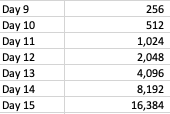
If payments stopped around days 9-15, the total would be WAY less than 21+ million. Think of virus cases as pennies. If you stop the process, you avoid the BOOM! like S. Korea did.
The earlier the better
The chart, below, is one of many in a brilliant article by Tomas Pueyo. It projects a 40% reduction in cases with just a single day’s difference in starting social distancing.
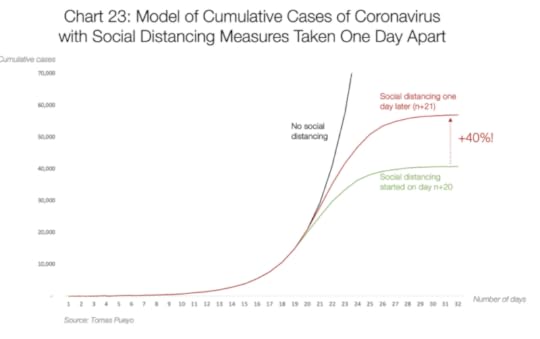
Right-click image to view a much larger version.
Take care of your pennies and coronaviruses
There is an old adage that says, “take care of your pennies and your dollars will take care of themselves.’
In a slightly altered analogy: take care of your coronaviruses (early) and you will take care of your entire population.
This is the part about how you kill Grandma …
… and your co-workers, friends, grocery clerks, medical workers, police, fire and other first responders …
A large percentage of people with COVID-19 may not show symptoms — Some estimates are as high as 50% to 78%. These people are known as “silent spreaders.” This article from the Wall Street Journal is a good background read.
It’s unknown so far how many people can be infected by a single silent spreader.
A CDC study using contract tracing in Chicago indicated that one silent spreader infected 16 people who attended a family funeral. Three of those subsequently died.
If a silent spreader infects only — 2 — other people, that’s the same geometric increase as the example of the 2 billion pennies
NOTE: Exponential and geometric growth are mathematically slightly different but represent the same sort of phenomenon.
January 25, 2020
First goal: save American journalism
The Situation
Online delivery has almost wiped out the news media … print and online
“For all the progress we have made, we still have not built a digital business large enough on its own to support a newsroom that can fulfill our ambitions,”— NYTimes
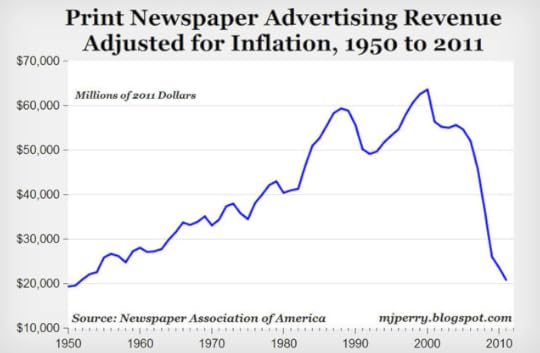
Click graphic to view a larger image.
… but online advertising is no solution. Problem is widespread, not just for newspapers
Facebook, Google, Amazon garner most advertising. The “Other companies” category, below includes large newspapers like the New York Times and Washington Post as well as every other newspaper, magazine and digital-only online publications.
It also includes other advertising supported digital media such as mobile apps, videos, video games, music and more.
No growth beyond the big 3. It’s not going to get better. Look at the lack of growth in the yellow part of the bar.

Chart from Economist.com, “Silicon Valley, we have a problem”
Also relevant: Something doesn’t ad up about America’s advertising market — The Economist
Despite subscription surges for largest U.S. newspapers, circulation and revenue fall for industry overall — Pew
OC Register and other Digital First Media newspapers face ‘significant’ layoffs — LA Times
Plummeting Newspaper Ad Revenue Sparks New Wave of Changes — Wall Street Jormal
Bonnier Lays Off 70 Employees; Shutters Five Print Titles — Folio
Decline of newspapers — Wikipedia
It’s a global problem
 Ad clutter, malware, data costs, slow page loads, and consumer annoyance in digital advertising have driven the rise of ad blockers
Ad clutter, malware, data costs, slow page loads, and consumer annoyance in digital advertising have driven the rise of ad blockersHere’s why the epidemic of malicious ads grew so much worse last year -Ars Technica
Time & expense: The Cost of Mobile Ads on 50 News Websites – New York Times
Consumers Don’t Like and Don’t Trust Digital Advertising — AdWeek

Source: Adobe/PageFair – 2017 adblock report. Right-click chart to view a larger image.
Digital ads just are not paying off
“For all the progress we have made, we still have not built a digital business large enough on its own to support a newsroom that can fulfill our ambitions,”— NY Times
The New York Times is obviously a special case which few in the world can match.
From: The New York Times’ digital business more than doubled in the past six years
But even given its 2.5 million unique visitors per day who look at an average of 2.6 pages (nytimes.com analytics), NYT is having trouble making ads at $8 per thousand impressions (NYT: Self-Service Advertising Help)
The vast majority of media and other web sites charge rates that fall in line with Google and Facebook: 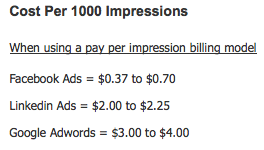
What does this mean for a web site? When someone places an ad on a web site charging $2/1,000 impressions, the ad has to be viewed 1,000 times before the web site makes $2. A “will work for food” sign scrawled on a scrap of corrugated cardboard can make a lot more than that.
Plus, digital ads mostly don’t work for the paying advertiser
Conversion rates (click-throughs) vary widely, but the average is 3.5% – The State of Conversion Rate Optimization
Digital ads: More expensive but reaching fewer consumers
The Average Website Conversion Rate by Industry (updated for 2017)
Display Ad CPM Rates
The Comprehensive Guide to Online Advertising Costs
New York Times: Subscriptions Über ads
Given its clout, the decreased number of free articles meted out and the compelling nature of its must-read content, the New York Times has been able to eke out enough long-term subscription revenues via credit cards to have subscriber revenues exceed advertising.
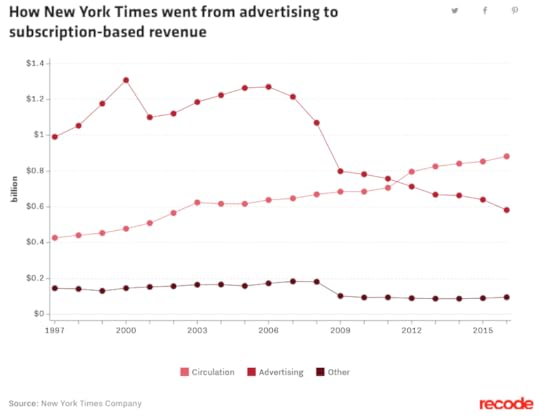
Interactive chart at the source: How the New York Times saved itself
Subscribers more profitable than ads
If subscribers are more important than ads, why don’t more online content sites emulate the NY Times? Because they are not the NY Times. Few have enough compelling, world-class, must-read content to overcome low-perceived value, consumer credit card reluctance, and time hassles.
Deep discounting further devalues news
Makes credit card hassles less appealing. For royalty account participants where a dollar buys a point — and 10 points can be redeemed for $1.00 of merchandise — the post could sell the month’s subscription for 10 points and get virtually the same monetary return.
Begging doesn’t always go over well (Even if you are well-known)
The VCH ability for visitors to have a quick, one-click purchase of a single article for points would contribute to the survival of this newspaper.
Fort the latest on this UK newspaper age, see: Guardian and Observer launch new tabloid format and digital redesign
Worth reading further:
How the New York Times saved itself
The New York Times’ digital business more than doubled in the past six years
New York Times’ Good Quarter Shows Its Separation From Newspaper Pack
nytimes.com analytics
Index of all documents
Value Clearing House – Summary
First goal: save American journalism
Why is news a good first entry into digital content loyalty payments?
Why would companies who offer loyalty programs like VCH?
Case history: Starbucks
VCH can solve most loyalty program dissatisfaction issues – incentive for corporate participation
How does VCH work?
Solution: Monopoly money for Monopoly digital content — The San Quentin wrapper solution
Proprietary and confidential information of Lewis Perdue. Not to be disclosed to or shared with third parties without written permission.
Why would companies who offer loyalty programs like VCH?
Financial: Improve balance sheet & Income statement
$100 Billion in Loyalty Points Are Unclaimed
77% of consumers participate in a retail loyalty program, 46% have joined a hotel program, and 40% are part of an airline program
Tax treatment of customer loyalty and rewards programs is more compicated (KMPG report pdf link)
New Revenue Recognition Standards Impact Loyalty Program Accounting and Incentive Point Liability
PWC study/slideshare
Loyalty Points Liability Management: Balancing Finance and Freebies
Loyalty today means a lot more than handing out points
New Generations require different loyalty programs: Study by Accenture
See Starbucks Case History for details on the following incentives:
Increase value and usefulness to users
Customer satisfaction: Expiring points and/or rewards seems like theft to customers.
Good PR: Supporting (fill in the blanks: good journalism, entrepreneurs, small business, etc. Especially valuable if points are designated to “media” category).
Promotion: VCH would allow a “gift a friend” ability to transfer rewards.
Promote company as a consumer-friendlu]u innovator
Make a difference/Goodwill: Donate rewards to charity
Be even more indispensible to Millennials and the upcoming iGen while maintaining loyalty of other demographics.
Index of all documents
Value Clearing House – Summary
First goal: save American journalism
Why is news a good first entry into digital content loyalty payments?
Why would companies who offer loyalty programs like VCH?
Case history: Starbucks
VCH can solve most loyalty program dissatisfaction issues – incentive for corporate participation
How does VCH work?
Solution: Monopoly money for Monopoly digital content — The San Quentin wrapper solution
Proprietary and confidential information of Lewis Perdue. Not to be disclosed to or shared with third parties without written permission.
How does VCH work?
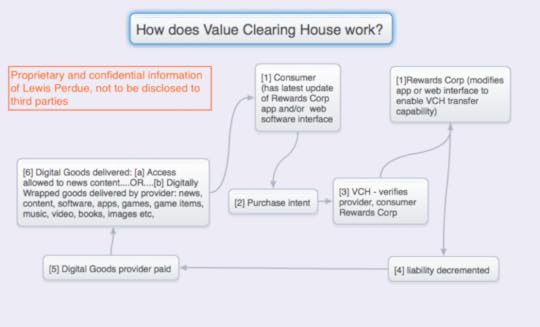
Click on graphic to view a larger image.
Index of all documents
Value Clearing House – Summary
First goal: save American journalism
Why is news a good first entry into digital content loyalty payments?
Why would companies who offer loyalty programs like VCH?
Case history: Starbucks
VCH can solve most loyalty program dissatisfaction issues – incentive for corporate participation
How does VCH work?
Solution: Monopoly money for Monopoly digital content — The San Quentin wrapper solution
Proprietary and confidential information of Lewis Perdue. Not to be disclosed to or shared with third parties without written permission.
Why is news a good first entry into digital content loyalty payments?
Demand. Demand. Demand.
Consumer demand

Click graphic to view a larger image.
See also:
Paying for news: Why people subscribe and what it says about the future of journalism
N.Y. Times Scales Back Free Articles, Gets More Subscribers
Why people pay to read The New York Times
 Also see: Who pays for news
Also see: Who pays for news
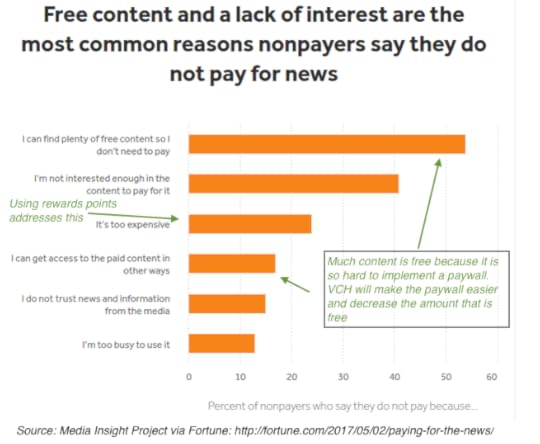 Also see: Who does not pay for news
Also see: Who does not pay for news
Consumer satisfaction: Why VCH loyalty points work better than credit cards for digital content
The difference is perceived value.
Digital content is a bitstream. It is insubstantial, cannot be touched or held. Consumers realized that — while the product has value — the delivery of digital content costs nearly nothing. The product is distantly separated from the original creation costs and efforts.
This insubstantiality and cheap cost of delivery has promoted a culture of “free.” Even before pirated music, movies, and games hit the mainstream, individual software developers pioneered “shareware” and “freeware.” The culture of free has firmly entrenched itself in the digital world, most disastrously in the media.
Loyalty points are similar to digital media in that consumers recognize they have value, but they are like “Monopoly money” — insubstantial and almost “free.” Points can be spent without concern for credit card debt, credit ratings, or commitments.
In short, loyalty points offer a decision process mostly free of serious consideration. This is another reason that casinos use chips instead of cash. Because chips are not cash, that makes a gambling decision easier to make because it hides the reminder that there is a cash consequence.
Credit cards are like casino chips to a lesser extent. However, the required entry of card and personal data, security codes are not only time consuming, but raise the specter of a hack that exposes that to criminals.
Current online credit card payment systems are a hassle for consumers
Current credit card systems require a far greater commitment decision on the part of the consumer. In addition, it requires additional time and effort including the need to find the card if all the data is not memorized.
Other barriers include
Fragmentation = friction. The frequent use of news aggregation operations such as Google mean that a consumer may read articles from a dozen or more sites in one sitting. Similar issues occur for news links visited from social media such as Twitter and Facebook. Many times, site visitors will run up against a paywall — “you have read the last of your free article.”
The need to pull out a credit card for each site often makes visitors click away.
Subscription commitments (usually with default auto-renew) are not feasible for multiple sites the consumer wants to visit.
Purchase per article not available (credit card transaction cost too high).
Current online payment systems are a hassle for media sites
Complicated set-up and maintenance for content payment systems like CCBill or Stripe
Per-article purchase not practical/cost-effective both technically and because of credit card transaction costs and additional fees to billing companies
Index of all documents
Value Clearing House – Summary
First goal: save American journalism
Why is news a good first entry into digital content loyalty payments?
Why would companies who offer loyalty programs like VCH?
Case history: Starbucks
VCH can solve most loyalty program dissatisfaction issues – incentive for corporate participation
How does VCH work?
Solution: Monopoly money for Monopoly digital content — The San Quentin wrapper solution
Proprietary and confidential information of Lewis Perdue. Not to be disclosed to or shared with third parties without written permission.




